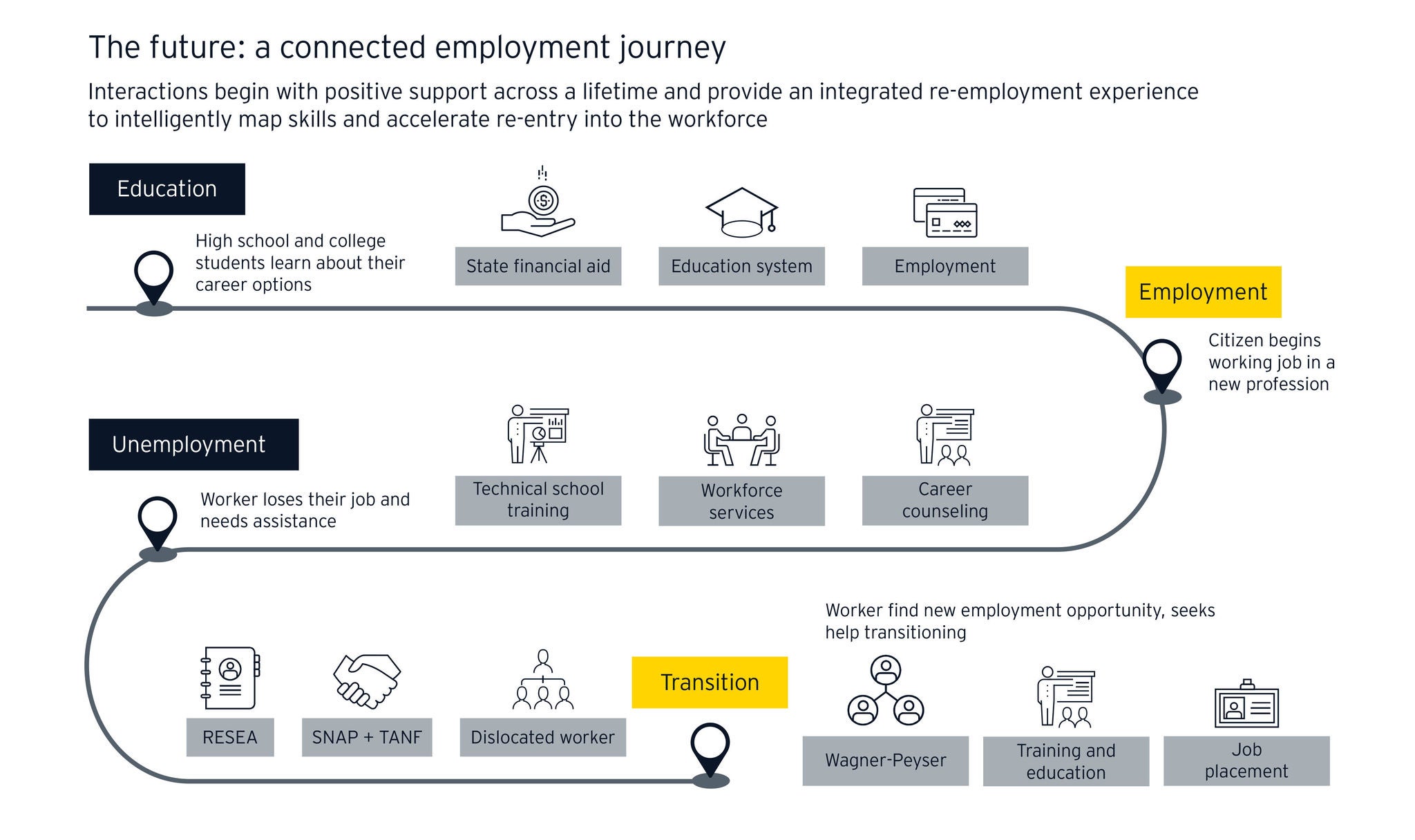EY refers to the global organization, and may refer to one or more, of the member firms of Ernst & Young Global Limited, each of which is a separate legal entity. Ernst & Young Global Limited, a UK company limited by guarantee, does not provide services to clients.
How EY can help
-
Our Government & Public Sector practice provides a full range of consulting, strategy, tax and audit services.
Read more
This means only 1% of unemployed people are receiving training.
Citizens usually first become introduced to workforce service programs when they file for unemployment. Today, the number of programs and the way they are organized can seem overwhelming and hard to navigate to some citizens, presenting barriers to accessing relevant services.
There is often little connectivity between application processes for unemployment and reemployment, leading to redundancy in the application processes where data could be shared to maximize efficiencies and personalize services. During the pandemic, the in-person appointments and manual application and case management processes that are typical in many states have become a significant impediment to citizens’ ability to swiftly access and enroll in needed reskilling and job placement programs.
Looking beyond COVID-19 to the future of workforce services, the question of whether workforce development agencies can engage citizens at an earlier stage in their career journey rather than being the resource of last resort becomes more relevant. Seeking employment and training for new skills and certifications has moved increasingly online in the last two decades, a trend that is only likely to continue to accelerate. With commercial digital platforms growing increasingly dominant in this space, state and local workforce services will face declining usage unless they can evolve to match the experience and utility of private enterprise.
We see four key challenges facing workforce development agencies that must be overcome for them to increase their relevance to citizens today and to position themselves as long-term career partners of citizens in the future of work.
Four key challenges facing agencies:
- Structural: While many workforce development agencies understand this current state and have envisioned ambitious programs to transform the services they offer and how they offer them, such programs are often the victim of lengthy delays and failed initiatives. There are structural reasons for this.
Transformation is an expensive and time-consuming endeavor. Many agencies have difficulty securing (and keeping) funding, and others lack the human resources and required skills to execute. While states may take incremental steps in developing point programs, they do not tie them into a larger, holistic strategy. Additionally, there is often misalignment between state agencies and local initiatives.
- Data and intelligence: Skilled talent is the driving factor in business location decisions today, though the full picture of skill sets required is hard to quantify. Employers have a wealth of information, but there is no easy way to specify the skills that are in demand. Even when workforce development agencies have access to data, they are not making this intelligence clear to end users, nor sharing it with employers and partners.
- Employer-agency alignment: The fragmentation of workforce services makes alignment challenging. Too many entities, including educational organizations, private job search and reskilling enterprises, and state and local agencies that may or may not be coordinated, are trying to collaborate with employers, leading to communications that are redundant, inconsistent or missing key players in the ecosystem to be effective. The rapid displacement of workers driven by COVID-19 and the ensuing mass relocation increase the need for data sharing between partnering entities to keep tabs on the shifting demographics of local and regional workforces.
- Skills development: Community colleges, technical schools and workforce agencies often compete to close the skills gap rather than working collaboratively. Available training may not meet the consumer-grade expectations of citizens or be responsive to employer needs. Supply-and-demand opacity creates a constantly moving target for programs and leaves citizens feeling frustrated when they have invested in training that may not be relevant to the needs of employers.
How can workforce agencies overcome these challenges?
Some of the key changes will include becoming more stakeholder-focused, stripping out complexity to make processes simple and efficient, developing best-of-breed curricula that meet the needs of tomorrow’s workforce and creating a unified experience for residents to find various types of support along their career journeys.
The future of workforce services puts people first
To better meet constituent needs, workforce agencies should pivot from being a safety net to a sought-after resource for career development, reskilling and new employment opportunities.
During the pandemic, the priority of states has been to return displaced citizens to the workforce as soon as possible. Not only do states have a vested interest in supporting their citizens, a healthy workforce also means increased tax revenue, economic growth and a boost to attracting the best employers and workforce to the state. By focusing on modernizing workforce development services, states can also realize performance gains through process efficiencies, cost savings and interagency collaboration.
Looking beyond the pandemic, states will need to adapt their services to meet the needs of tomorrow’s workforce. They will need to help close the technical skills gap, starting with less-educated workers who are at risk of sinking below the poverty line, and moving upstream to serve a broader range of citizens who are looking to reskill to stay relevant in a rapidly changing job market.
Employers will continue to value employees with relevant training and certifications as four-year degrees begin to look less desirable by comparison in a world where workers need to focus on lifelong learning to stay relevant.
Shifting from being a resource of last resort to a connected employment journey
Today, a citizen’s engagement with unemployment and workforce development services begins when they lose their job. Services are siloed, with citizens at first filing an unemployment insurance claim. At the same time, in some states, they might be asked to complete an application for workforce development services as a prerequisite to accessing unemployment relief. In the current state journey, access to employment and reskilling services becomes just another barrier to receiving funds rather than an integrated, supportive experience.
The ideal future state we envision for states is one in which they play a much larger and connected role in the lives of their constituents. States need to consider the full career journey of a citizen and seek to play a supportive role in as many phases as possible, to be viewed as a trusted partner rather than an outpost to be visited at the lowest point of the career path.
States can start to engage as early as secondary education by finding ways to get involved in helping students learn about their career options through services such as guidance counseling, state financial aid, refinancing, job search assistance and school housing. By establishing a bond with students from a young age, workforce agencies will be more likely to be viewed as a partner of choice as they continue to progress in their careers and look for resources such as career counseling and training programs.
Modernizing the reemployment experience
Playing a more connected role in citizens’ lives will require a technological leap forward for most workforce development agencies. Citizens have been conditioned through years of interactions with commercial e-commerce platforms and digital consumer services to expect seamless, pain-free interactions and transactions. Today’s enrollment and case management processes at states tend to be paper-based, in-person and manual, creating numerous pain points for citizens.
These include confusion about the enrollment process and eligibility requirements, advocacy that is program-oriented rather than citizen-oriented, and time-consuming processes requiring multiple, in-person visits to agency offices. While some degree of in-person and paper-based services is required today to support low-income workers with limited access to technology, as the digital divide is bridged, consumer-grade digital services will be increasingly expected.
Workforce agencies should look to accelerate the modernization of their systems to meet citizen expectations and improve their service levels. This means both designing user experiences for onboarding and case management that are simple and intuitive, while also building a flexible and scalable back-end architecture to reduce long-term costs and accelerate future enhancements.
Architectures that leverage contemporary design standards such as the use of microservices and select best-of-breed vendors to support modules such as data management, identity management, learning management and content management will stand a better chance of being able to pivot quickly to match the speed of change in the jobs market. Advantages of this style of architecture include enhanced integration with third parties that allows for faster deployment of new services, data interoperability and functional modules that can be repurposed and extended rather than rebuilt (reducing the cost of maintenance), and the ability to offer data-driven recommendations that are smart and personalized.
The future: a connected employment journey
Interactions begin with positive support across a lifetime and provide an integrated re-employment experience to intelligently map skills and accelerate re-entry into the workforce.





